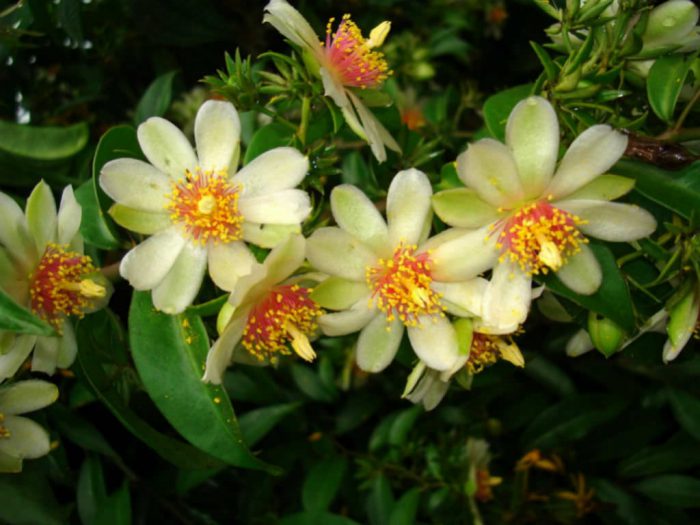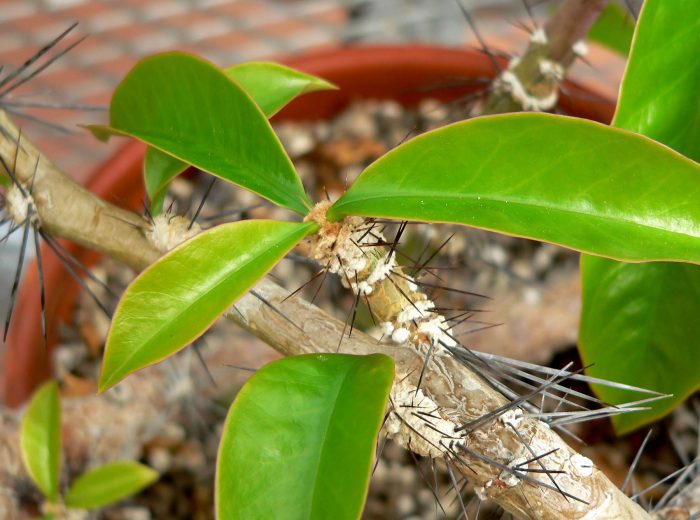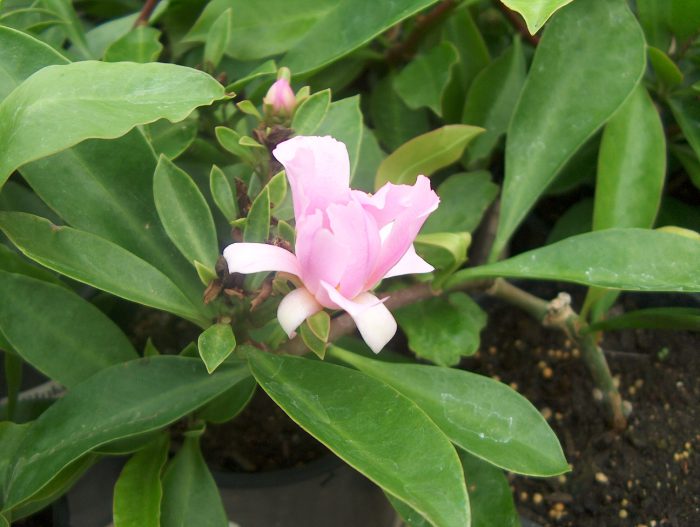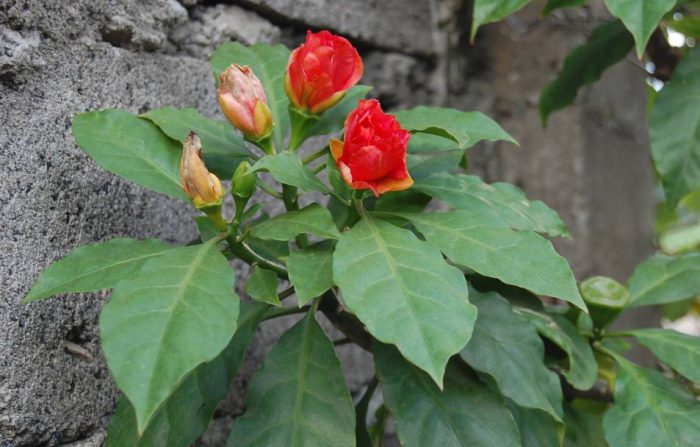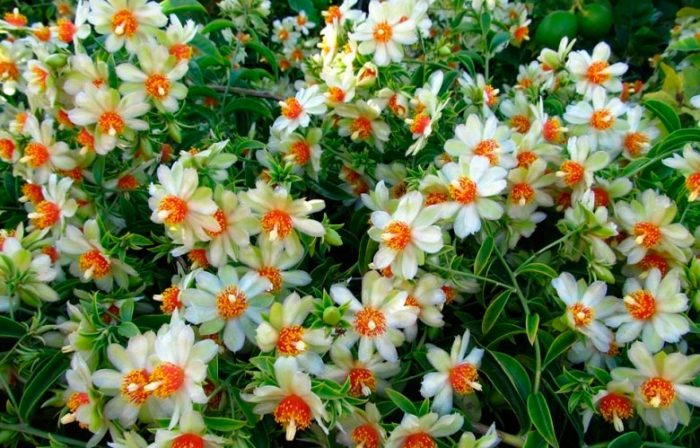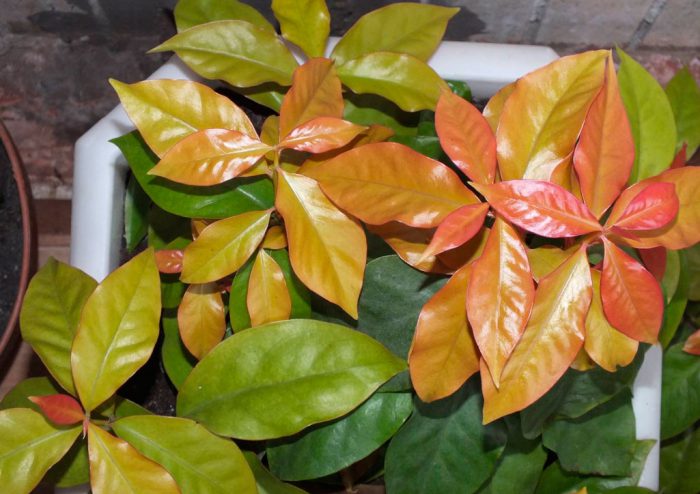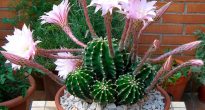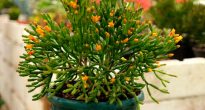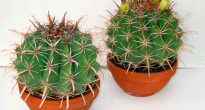Such an ancient genus of cacti as pereski (Pereskia) is considered a member of the cactaceae family (Cactaceae). This plant is native to Central and South America. The first cacti, which are the ancestors of modern ones, possessed foliage, but over time, it transformed into thorns due to the too hot and dry climate. The stem of this plant began to perform all the functions of foliage.
The first plant of this kind was described by C. Plamier in 1703. This genus was named after the scientist Nicola-Claude de Perese, who was French. The Pereskians became members of the cactus genus thanks to Karl Linnaeus. However, in 1754, they were separated into a separate genus of Peresky by Philip Miller.
Most of these plants are short trees or rather large shrubs that have thorny powerful stems. Their foliage is colored purple or green. Areoles are located in the leaf sinuses, from which single spines grow, they can also grow in bundles. In nature, these thorns are very important for peres, as with the help of them the plant clings to tree trunks. Over the years, the foliage of this plant turns pale, begins to dry out gradually, and with the onset of a dormant period, it flies around.
Caring for ossification at home
Illumination
This plant is very fond of light. Experienced florists advise placing it next to south-facing windows. It should be borne in mind that from the scorching midday sun, the cactus must be shaded so that burns do not form on its foliage. In the summer, it is best to move the crossing outside. For her, in this case, you should choose a place that will be well protected from precipitation. In the event that it is not possible to take the plant outside in the summer, it is necessary to systematically ventilate the room where it is kept.
In winter and autumn, a cactus also needs a lot of light. With the onset of the spring period, there is a significant increase in the level of illumination, while switching to it must be gradually taught.
Temperature regime
It needs warmth (22-23 degrees), while the air should not stagnate in the room, and regular ventilation will help to avoid this. In autumn, the plant is placed in a cooler place (about 15 degrees), while it must be prepared for the upcoming dormant period.In winter, the cactus has a dormant period. At this time, he needs a relative coolness of 12 to 16 degrees, good lighting and systematic ventilation of the room. It should be noted that the room where the cactus is located should not be cooler than 10 degrees.
Humidity
Air with a low moisture content is quite suitable for the content, but the cactus foliage looks more impressive if it is regularly moistened with soft water from a sprayer.
How to water
In the spring and summer, water the plant as the soil in the pot dries up. In autumn, it is necessary to water less and less each time. And in winter, watering should be very poor, but at the same time, make sure that the foliage does not fall off.
Top dressing
Top dressing is carried out in spring and summer 1 time in 2 weeks. To do this, use fertilizers for cacti (take ½ part of the dose recommended on the package). In winter, fertilizers should not be applied to the soil. When choosing a fertilizer, it should be taken into account that a high level of nitrogen is dangerous for pereskii, because it can provoke rotting of the root system.
Earth mix
Suitable soil should be loose, nutrient-rich and humus-filled. To prepare the soil mixture, it is necessary to combine clay-sod and leafy soil, sand and humus in a ratio of 2: 2: 1: 2.
Transplant features
Young specimens are transplanted into larger pots several times a year (as they grow up). In order not to damage the roots, it is recommended that you carefully transfer the cactus from pot to pot. Adult plants are subjected to this procedure only if absolutely necessary, for example, when the roots no longer fit in the pot.
When planting, it should be borne in mind that the roots of this cactus are quite powerful, therefore, a container suitable for planting should be quite voluminous and wide. Don't forget a good drainage layer. After a short time after the transplant, a sharp spurt in growth is observed in the pereski.
Reproduction methods
This plant can be propagated by cuttings and also grown from seeds.
Seeds are sown in boxes in the spring and placed in heat (20 to 22 degrees).
Cuttings are carried out in the spring and summer. Cut off the cuttings on which 1 or 2 nodes are located. They are planted for rooting in a moist substrate consisting of peat and perlite, and covered with a film on top. To speed up rooting, they are placed in heat (from 25 to 28 degrees). Water is also great for rooting. Rooting occurs rather quickly after 14–20 days. After rooting, the cuttings are transplanted into pots, while doing this very carefully so as not to damage the roots.
Pests and diseases
The root collar and roots begin to rot during overflow, especially during a cool winter. The reason may be in poor soil drainage or drainage layer. Be sure to follow the watering rules and use only suitable soil for planting.
Gray rot of vegetable crops appears on separate areas of the shoots. High humidity or stagnant air in the room can contribute to its development. Place the plant in more favorable conditions for growth and treat it with special chemicals.
Can settle mealybugs... If there are few cacti, then the pests are cleaned off with a brush with stiff bristles. Treat the plants with an anti-coccid drug if necessary.
Mites and thrips can also settle, which harm shoots, foliage and flowers. To get rid of them, drugs of the appropriate action are used.
Growing difficulties
- The foliage turns pale - a lot of light.
- Stopping growth - poor watering in summer or overflow in winter, the plant was not transplanted on time.
- Shoots are stretched - little light.
- The tip of the shoot wrinkles, spots of soft rot can be found below - stagnation of moisture in the soil (especially in winter).
Main types
Pereskia grandiflora (Pereskia grandiflora)
Shiny leathery leaves fall off with the onset of winter, but only if the room is less than 10 degrees. The stem is covered with a large number of thorns, the length of which can be equal to 2 to 3 centimeters. Flowers collected in inflorescences are painted pink.
Orange pereskia (Pereskia bleo)
On rather large leaves, veins are clearly visible. Red-orange flowers reach 5-6 centimeters in diameter. They resemble small roses and open at the end of the day. The cone-shaped fruits of a rich yellow color resemble pineapple in their aroma, but they should not be eaten. Regular pruning is recommended to keep the cactus neat and compact.
Pereskia aculeata
This climbing bushy cactus has a strongly branching fleshy stem that reaches only one and a half centimeters in diameter. Dark green leaves have a lanceolate or oval shape, they reach 9 centimeters in length and 4 centimeters in width. Over the years, the lower leaves fly around, and in this part of the plant only brownish areoles remain, from which from 1 to 3 hard and straight spines with a brown color emerge. There are also 2 curved short spines that are located under the base of the leaf in the lower part of the areola. In the last summer or first autumn weeks, the cactus begins to bloom. Flowers are located only on young stems. They are cupped and painted in a whitish yellow color with a pinkish tint. Each slightly fragrant flower can reach 2.5 to 4.5 centimeters in diameter. Yellow two-centimeter fruits can be eaten.
Pereskia aculeata var. Godseffiana
It is also a fairly popular variety, but at the same time in some sources it is distinguished as a separate species (Pereskia godseffiana).

